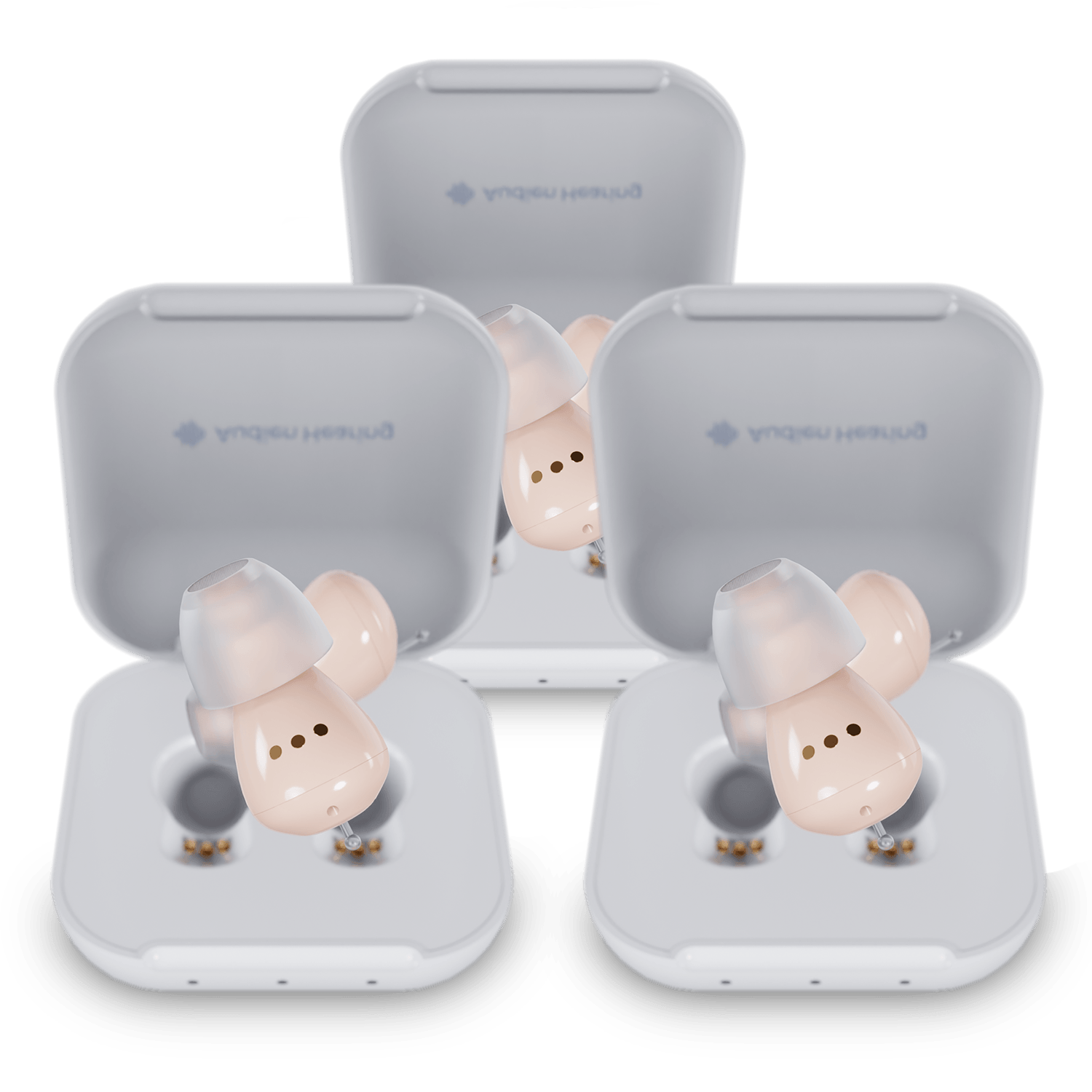Many people think of hearing loss as a binary condition, but the reality is that it occurs on a spectrum. Hearing loss can be as minor as having a hard time hearing a certain frequency or as severe as having near-deafness.
With such a high level of variation, each person’s case of hearing loss is unique. Understanding everything you need to know about your given degree of hearing loss can allow you to get the appropriate assistance you need.
Below is a closer look at each category of hearing loss, how hearing loss happens, as well as everything you need to know about hearing loss.
How Does Hearing Loss Happen?

Hearing loss can be a difficult diagnosis to grapple with. Years ago, your hearing was most likely completely intact. Now, you are being informed that you have lost some of your ability to hear. Age-related hearing loss is a common problem faced by a large portion of the population, but few actually understand the underlying reason as to why their hearing has diminished.
Below is a closer look at the underlying reasoning for how your ability to perceive sound diminishes. Understanding the underlying science and physiology behind hearing loss can help to demystify hearing loss. It can allow you to take action to protect and preserve the hearing you have.
How Does Hearing Work?
Humans have a wide array of senses that allows us to obtain information from the environment around us. Vision, taste, touch, smell, and hearing all allow for you to go about your day-to-day. While most people don’t give a second thought to how these senses work, it can be an essential bit of knowledge to have in your tool belt.
Hearing is the sense that allows us to detect the pressure differences in the air around us that are caused by vibrations. When an item vibrates, it emits sound waves, which cause disturbances in the air.
These travel from the source of sound to your ear, where the outer ear funnels sound into the ear canal. At the end of the ear canal, there is a thin membrane known as the eardrum. It oscillates back and forth from the changes in air pressure. Behind the eardrum, there are a series of small interconnected bones that conduct that movement to the inner ear.
The inner ear is the part of the ear that transfers the movement into a neural signal that is relayed to the brain and perceived as sound. The inner ear works thanks to an organ called the cochlea. The cochlea is a hollow snail-like structure containing hundreds of sensory hairs within it.
The middle ear bones strike the inner ear and send vibrations throughout the cochlea. Each hair in the cochlea is tuned to a specific frequency of sound. When the frequency is detected, it bends, which is what sends a nerve impulse.
What Is Conductive Hearing Loss?
Conductive hearing loss is a form of hearing loss that occurs before the inner ear. Things like ear canal blockages, a ruptured eardrum, or problems with the middle ear can all contribute to conductive hearing loss.
Many cases of conductive hearing loss can get better over time, and hearing can typically be regained. Conductive hearing loss can either occur in both ears or a single ear, also known as bilateral or unilateral hearing loss.
What Is Sensorineural Hearing Loss?
Sensorineural hearing loss is hearing loss that occurs in the inner ear of the auditory nerve itself. Unlike conductive hearing loss, there is little that can be done to regain hearing from sensorineural hearing loss.
The most common issue that causes sensorineural hearing loss is a decreased sensitivity of the hair cells in the cochlea. A lifetime of sounds or just exposure to loud sounds can over time damage the hairs and reduce their ability to detect their specific frequency.
This requires a higher intensity of sound to be detected. This is why many people with hearing loss need people to talk at a higher volume to hear them.
The Degrees of Hearing Loss
While hearing loss has two main types, there is one scale that is utilized across the board to determine the severity of hearing loss, and that is the hearing loss scale.
The hearing loss scale utilizes a decibel hearing loss (dB HL) scale that provides a numerical value to the volume of sound you are able to perceive. The higher the hearing loss range, the more severe the hearing loss is.
The hearing loss scale is valuable because it helps people to understand how severe their hearing loss is. It also provides information on the best ways to help. Below is a closer look at the degrees of hearing loss, their decibel hearing loss ranges, and things you may have difficulty hearing.
Slight Hearing Loss
Slight hearing loss has a hearing loss range of 16-25 dB HL. Essentially, this means that if the quietest sound you can hear is within this range, you have slight hearing loss. Unlike other forms of hearing loss, slight hearing loss is likely to have a small impact on your ability to effectively communicate with others.
Sounds that may be difficult for those with slight hearing loss to hear includes whispers, birds chirping at a distance, and possibly some word sounds while talking at a quiet level. Slight hearing loss is typically either gone undiagnosed or simply dealt with since it is fairly easy to live with.
Mild Hearing Loss
Mild hearing loss has a hearing loss range of 26-40 dB HL. 40 dB is about the noise level you would encounter in a quiet library. Mild hearing loss is unlikely to get in your way on a day-to-day basis. However, it could hinder the ability to hear lightly spoken words. In addition, it can be more difficult to understand people when in an environment with a lot of competing background noise.
Mild hearing loss can pose the potential to get in the way of your day-to-day living, and you may want to consider hearing aids to help ensure you stay engaged in conversations.
Moderate Hearing Loss
Moderate hearing loss has a hearing loss range of 41-55 dB HL. Normal conversation levels hover around 60 dB, which means that those with moderate hearing loss are likely to have some difficulty hearing what people are saying. If you add in the complexity of a noisy background, those with moderate hearing loss are likely to miss out on what is being discussed.
With moderate hearing loss, it is typically recommended to get hearing aids to help boost these sound levels above your hearing threshold to allow you to retain your ability to verbally communicate.
Severe Hearing Loss
Severe hearing loss has a hearing loss range of 71-90 dB HL. Those with severe hearing loss are unlikely to be able to hear normal speech. They may mainly only hear loud sounds such as a motorcycle, lawnmower, and power tools. Hearing aids are immensely helpful to those with severe hearing loss and can allow them the ability to partake in conversations.
Profound Hearing Loss
Profound hearing loss is the highest degree of hearing loss, and it is essentially considered to be near-deafness. Most sounds are unable to be perceived by those with profound hearing loss. Only sounds at very high volumes are able to be perceived, and even then, they may not be distinguishable.
Hearing aids can help the profoundly hearing impaired, but they may require specialty hearing aids that have enough power to amplify sounds above their high hearing threshold.
Other Things You Should Know

Degree hearing loss is a great way to quickly convey the amount of hearing loss present, but there is much more to hearing loss that you should know.
Below is a closer look at everything else you should know about hearing loss:
How Is Degree Hearing Loss Determined?
Hearing loss is determined by a hearing test known as an audiometry test. An audiometry test is conducted by an audiologist. In this test, they utilize headphones and a series of tones to evaluate hearing acuity.
Tones are played at varying volumes, and the lowest intensity is recorded. After the test, you will have a fuller understanding of what sounds you are and are not able to hear. The degree of hearing loss can then be determined.
What Can Help With Hearing Loss?
One of the best things you can do for hearing loss is to get hearing aids. Hearing aids are small devices that detect sound and amplify them to a louder volume. Most hearing aids have a volume adjustment to customize your hearing aids to your specific degree of hearing loss. The Audien EV1 is one great option to get you into hearing aids at an inexpensive price point.
Knowledge Is Power
The degree of hearing loss is a measure of how severe hearing loss is. Hearing loss can be caused by a dysfunction in any part of the ear, but they can all result in a decreased ability to perceive sounds. Understanding the different degrees of hearing loss can give you a fuller understanding of hearing loss and where you fall on the spectrum.
Sources













